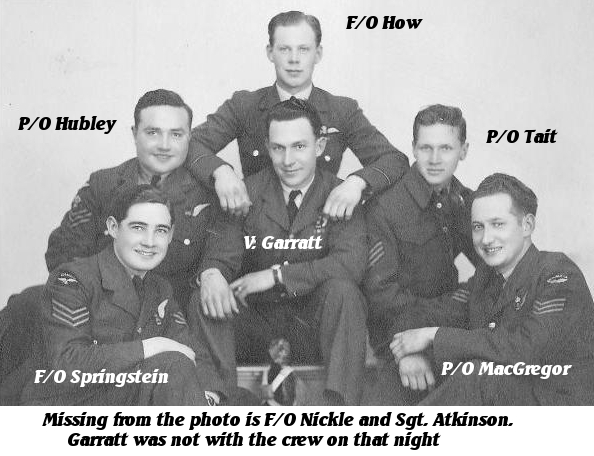Family Connection
It stared down at me from as long as I can remember, the photo of a group of men in front of a big plane with an Octopus painted on the side. It hung in my dad's workshop and he was one of the men in the photo. kneeling down with others of the ground crew and a few of the aircrew standing behind them.
She was Lancaster KB738, VR-D and like her predecesor KB716 VR-D was an aircraft my father was responsible for maintaining.
KB716 would be the first of the squadron's Lancasters to carry the VR-D on her side. Arriving sometime prior to May 1st. of 1944. The first captain of KB716, was F/L Arthur Byford , who my father would get to know well over the years. Of course Byford was not the only "borrower" of KB716, for you see in the eyes of the ground crew they were the owners the aircrew just borrowed it, but F/L Byford was the main "borrower" for the short life of KB716 as VR-D.
KB716 takes a bad landing in stride
Air crews were either on operations or doing training exercises. By now KB716 had only been on squadron strength for a little over a month when while returning from a night training exercise F/L Byford, a very experienced pilot who had been with the squadron for a while managed to badly damage VR-D. No exact date is recorded but sometime between June 7th and June 12th he and his crew had a close call. His crew were not injured in the crash. As for VR-D, she required extensive work before her return to the squadron as VR-E.
KB738 steps in as VR-D "Dorothy"
On June 12th, KB738 newly arrived is given the VR-D call signs. F/L Byford and his crew including P/O Fraser and his newly awarded DFM use VR-D right up to the completion of their tour at the end of June. And for the first two weeks of July KB738 is loaned out to a number of different captains and crews.
F/O Calder and Crew
By the 12th of July VR-D had a new crew who would take the controls of "Dorothy" right up to the first week of October.
F/O James Harold Calder's crew:
Navigator F/O A. G. Angus
Bomb Aimer F/O M. John Bernardi
W/Op F/O E. G. F. Bryan
F/E Sgt. R. G. King
A/G L.L. Montgomery
A/G W. W. Collette
 And although the Calder's crew would complete their tour in KB738 flying operations supporting
the troops in Normandy and trips up through the "Happy Valley" there are only two events recorded which reveal any
problems occurring. During an operation on Caen on July 18th. the Bomb Aimer pressing the release button caused
a short in the electronic distributor which started a fire, luckly the B/A was able to put it out. But which left
them with a thousand pound bomb hung up in the racks. They did manage to jetison the bomb eventually so they could
land without fear of it bouncing on the runway.
And although the Calder's crew would complete their tour in KB738 flying operations supporting
the troops in Normandy and trips up through the "Happy Valley" there are only two events recorded which reveal any
problems occurring. During an operation on Caen on July 18th. the Bomb Aimer pressing the release button caused
a short in the electronic distributor which started a fire, luckly the B/A was able to put it out. But which left
them with a thousand pound bomb hung up in the racks. They did manage to jetison the bomb eventually so they could
land without fear of it bouncing on the runway.Their vist operation in September to Emden, found them in heavy flak near the target area. On flak fragment pierced the fuselage directly behind the pilots seat. The flak had no effect on the pilot or the crew and on landing numerous other holes were found in the wings. By November of '44 Calder and his crew had completed their tour. Most of the crew headed for "R" Depot then home, except for F/L Bryan who was posted to No. 1659 CU as instructor, and P/O King who was posted to No. 1666 CU for instructional duties.
The Loss Of VR-D
KB738 was becoming a veteran by now, seeing crews savely home from many operations deep into enemy territory. On the night of December 27/28th 1944, VR-D was on it's 68th operation with it's new captain, F/O Fredrick How at the controls on an operartion to Opladen. The cause of the loss is unknown, only that she came down at Leverkusen-Wiesdorf. All of her the crew were lost. The bodies were buried locally until being moved after the war to Rheinberg War Cemetery.
The crew were:
Pilot F/O Fredrick Winston How, age22
Navigator F/O Russel Karl Nickle, age 27
F/E Sgt. Joseph Atkinson RAF
B/A WOII John Alfred Stuart MacGregor, age 26
WAG P/O Cecil David Benjamin Hubley, age 20
A/G P/O Cecil Ralph Tait
A/G F/O Norman Ray Springstein, age 19
From my father's Diary, VR-D's ground crew Sergeant
" it was a sad night when you would see one of your crews who made it through more then half their opertaions and not come home, it was a sad night when any crew never made it home"
F/O Fredrick How and his crew had reached the halfway mark in their tour when they were lost.


